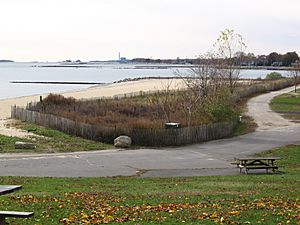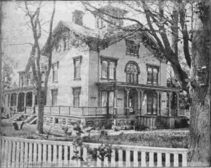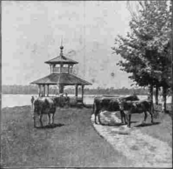Manresa Island facts for kids
| Etymology | Named for the Manresa Institute, which itself was named after Manresa, Spain |
|---|---|
| Geography | |
| Location | Long Island Sound |
| Coordinates | 41°4′29″N 73°24′36″W / 41.07472°N 73.41000°W |
| Area | 144 acres (58 ha) |
| Highest elevation | 7 ft (2.1 m) |
| Administration | |
|
United States
|
|
| State | Connecticut |
| County | Fairfield County |
| City | Norwalk |
Manresa Island is a piece of land in Norwalk, Connecticut. It sits where Norwalk Harbor meets the Long Island Sound. This land was once a true island.
Its first known name was Boutons Island in 1664. Later, a man named John H. Keyser bought it. He lived there and grew special plants. In 1860, he built a causeway, which is like a bridge, to connect the island to the mainland. This led to the name Keyser Island.
Later, a religious group called the Jesuits bought the island. They created the Manresa Institute there. This was a special place for people to go for quiet reflection and spiritual growth, called a "retreat." The institute was named after Manresa, a town in Spain. This is where Saint Ignatius of Loyola, who started the Jesuits, wrote his Spiritual Exercises.
In the 1950s, a company built a power plant on the land. Over time, they added a lot of material, including coal ash, to the surrounding areas. This made the land much bigger, growing from about 23 acres to 144 acres. This process also caused some pollution. The power plant closed in 2013 after Hurricane Sandy damaged it. Today, part of Manresa Island is an important natural area for marine life.
Contents
Exploring Manresa Island's Past
The earliest records of this land go back to 1664. Back then, it was called Boutons Island. It is located in the Long Island Sound, right at the entrance of Norwalk Harbor. The island is part of the city of Norwalk, Connecticut. It sits across the harbor from the popular Calf Pasture Beach.
Keyser Island and Its Causeway
The island was once owned by John H. Keyser. He lived there, and that's how it got its later name, Keyser Island. In 1860, he spent a lot of money to build a causeway. This causeway connected the island to the mainland, allowing carriages to cross from South Norwalk.
Keyser turned the island into a park. He planted many rare trees and plants there. He even built a greenhouse. Keyser eventually sold the island to the Jesuits around 1888 or 1889.
The Manresa Institute: A Place for Retreat
Around the late 1800s, more people became interested in religious retreats. These were times for quiet reflection and spiritual growth. The Jesuits wanted to create a special place for these retreats. They wanted it to be open to all kinds of people, from workers to bankers, no matter how much money they had.
At first, retreats were held at Fordham University during the summers. But a more peaceful and permanent spot was needed. Keyser Island was chosen because it offered a quiet place for reflection. Eventually, all retreats moved from Fordham to Keyser Island.
The Jesuits officially opened the Manresa Institute on Keyser Island on April 21, 1889. It was the only place in the United States built just for retreats. The institute was named after the Spanish town of Manresa. This is where Saint Ignatius of Loyola, the founder of the Society of Jesus, wrote his Spiritual Exercises.
When the retreat center opened, the city of South Norwalk was two miles away. The island itself was very quiet. Besides the Jesuits who led the retreats, no one else lived on the 23-acre island. The Jesuits built one main building, called Manresa House. They also built two smaller cottages.
The center became a very important place for retreats. Even newly appointed bishops would visit before their ordination. In 1911, the Manresa Institute moved to Staten Island in New York City. It continued to operate there until 1927. Keyser Island kept its name until around World War II. After that, it officially became known as Manresa Island.
The Manresa Island Power Plant

After the Jesuits sold the land, the Norwalk Zoning Commission approved a plan in 1953. This plan allowed Connecticut Light & Power to build a coal-fired power plant on the island. Even though some local people were against it, the plant was built. It started operating in 1960.
In 1969, a large oil spill happened. This caused a lot of environmental harm to the beach at Village Creek and the nearby tidal flats. By 1972, the plant switched from burning coal to burning oil. In 1980, it was officially recognized that the plant had caused environmental damage. By the late 1990s, the island and plant were known to be heavily polluted.
In 1999, NRG Energy bought the power plant. They continued to run it. When Hurricane Sandy hit in 2012, almost the entire island was flooded. Because of the damage, the plant was permanently shut down in June 2013.
How Manresa Island Grew in Size
The original Keyser Island was only about 23 acres. But the island grew much larger over the years. Most of this growth happened after the power plant was built. The first materials added were likely earth from the power plant's construction.
A lot of land was filled in, creating two main sections. The northern section is undeveloped land. It was created when the power company was allowed to dump large amounts of coal ash there. This ash was a leftover product from the power plant. The southern section holds the original, smaller island. This part has the old power plant and other equipment. It also has an electrical substation.
Because the surrounding marshes were filled in over time, the southern section is now about 46.9 acres. The northern section is about 97 acres. This means the entire area of land is now around 144 acres.
Manresa Island's Amazing Biodiversity
The undeveloped part of Manresa Island is very special. It has a coastal forest and intertidal estuaries. These are some of the last undisturbed marine habitats on the Fairfield County coast. The island also has important wetlands.
These natural areas are breeding grounds for migratory birds. About 200 different bird species live there or visit. The waters around Manresa Island are also important habitats for many kinds of fish.





